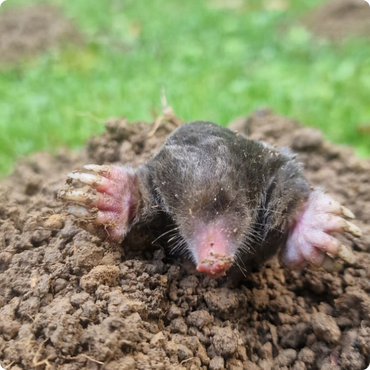Humane Wildlife Management: Fox and Mole Control in Urban Areas
As cities continue to expand and human settlements encroach upon natural habitats, interactions with wildlife, particularly foxes and moles, are becoming more frequent in urban areas. While these animals play important roles in the ecosystem, they can also cause issues for property owners, gardens, and public spaces.
The challenge is finding a balance between managing these animals humanely and protecting urban areas from potential damage. In this article, we will explore effective humane wildlife control methods for managing foxes and moles in urban environments, focusing on non-lethal strategies that minimise harm to both wildlife and humans.
Understanding Urban Wildlife: Foxes and Moles
Before diving into control methods, it’s essential to understand the behaviour and habitat of these animals. This knowledge helps create more effective and humane solutions.
Urban Foxes
Foxes are highly adaptable creatures and have thrived in urban environments, often scavenging for food from bins, gardens, and even pet food left outdoors. They are omnivores, feeding on small mammals, insects, fruits, and any leftover human food they can find. While foxes are generally not dangerous to humans, they can pose problems for pet owners and gardeners due to their habit of digging up lawns, flowerbeds, or raiding chicken coops.
Moles
Moles, on the other hand, are burrowing animals that primarily feed on insects, grubs, and earthworms. They are excellent diggers, creating extensive tunnel systems under lawns and gardens, which can lead to unsightly molehills and potential damage to plant roots. While they are beneficial for aerating soil, their burrowing can become problematic for well-maintained landscapes in urban areas.
Humane Wildlife Control: Why It Matters
Humane wildlife management seeks to balance the need to protect property with the responsibility to treat animals ethically. Traditional methods of wildlife control, such as trapping and poisoning, not only cause unnecessary suffering but can also disrupt local ecosystems. Furthermore, using harmful substances can pose risks to pets, non-target wildlife, and even humans.
Humane methods emphasise non-lethal approaches that focus on deterrence, exclusion, and habitat modification. This ensures that wildlife can coexist with human populations without causing damage or danger. Importantly, humane wildlife control aligns with environmental conservation goals and fosters a more ethical relationship with urban animals.
Humane Fox Control in Urban Areas
Foxes can be clever and persistent animals, which makes controlling them challenging. However, there are several humane strategies that can help deter foxes from causing damage to urban properties:
Exclusion and Physical Barriers
One of the most effective ways to control foxes is to prevent them from entering areas where they might cause damage.
- Secure Your Garden or Yard: Install fox-proof fencing around your garden or property. This fencing should be at least 6 feet high, with a buried section to prevent foxes from digging underneath.
- Protect Small Livestock: If you keep chickens or rabbits, ensure their enclosures are fully secure with sturdy mesh and locked doors, especially at night.
Eliminate Attractants
Foxes are opportunistic feeders and will be attracted to easily accessible food sources. Reducing food availability is key to making your property less appealing.
- Secure Rubbish Bins: Use bins with tight-fitting lids to prevent foxes from scavenging through your rubbish.
- Remove Pet Food: Bring pet food indoors at night and clean up any leftovers that may attract foxes.
- Compost Carefully: Keep compost bins tightly closed to prevent foxes from digging for food scraps.
Fox Repellents
Several humane fox repellents are available that can help deter them from entering your property.
- Scent Deterrents: Foxes have a keen sense of smell. Using commercially available fox repellents, which often contain predator urine, can signal danger to foxes and encourage them to leave the area.
- Motion-Activated Sprinklers: These devices use sudden bursts of water to startle foxes and can be placed around gardens or near known entry points to prevent them from accessing certain areas.
Habitat Modification
Urban areas that provide shelter or nesting sites for foxes can encourage them to stay. Modifying their environment can make your property less hospitable.
- Clear Debris: Remove brush piles, wood stacks, and other debris where foxes might build a den.
- Seal Crawl Spaces: Make sure crawl spaces under decks or sheds are sealed off to prevent foxes from creating a den.

Humane Mole Control in Urban Areas
Moles, though beneficial for soil health, can quickly become a nuisance when they create large tunnel systems in gardens, parks, and sports fields. However, there are humane ways to manage mole populations without resorting to harmful chemicals or traps.
Physical Barriers
Installing physical barriers is one of the most effective and humane ways to prevent moles from damaging specific areas.
- Mole Mesh or Fencing: Installing mesh barriers underground can prevent moles from accessing gardens or lawns. The mesh should be buried at least 2 feet deep and extend horizontally to stop moles from tunnelling under it.
Mole Repellents
Several natural mole repellents can be used to encourage moles to move on without harming them.
- Castor Oil-Based Repellents: Moles dislike the smell of castor oil. You can apply a castor oil mixture to your lawn or garden to make the area less appealing. Commercial mole repellents often contain castor oil as the main ingredient.
- Vibrational Devices: Solar-powered mole repellents that emit vibrations or sounds underground can effectively drive moles away by disturbing their tunnel systems.
Encouraging Natural Predators
Moles have natural predators, such as owls and hawks, which can help keep their population in check.
- Install Owl Boxes: By encouraging owls to nest nearby, you can attract a natural predator that will help control the mole population in your area.
Habitat Modification
Altering the habitat can make your property less attractive to moles, helping to reduce the likelihood of an infestation.
- Limit Watering: Over-watering lawns can attract more insects and grubs, which in turn attract moles. By reducing watering, you can reduce the food supply that draws moles to your property.
Conclusion
Humane wildlife control is essential for managing urban populations of foxes and moles in a way that minimises harm to the animals while protecting human interests. By focusing on non-lethal methods such as exclusion, repellents, and habitat modification, property owners can effectively manage wildlife without resorting to inhumane or environmentally harmful practices.
Whether you’re dealing with foxes scavenging in your garden or moles burrowing through your lawn, adopting humane and ethical wildlife control solutions ensures a balance between urban living and wildlife conservation. With the right approach, humans and wildlife can coexist in urban environments, maintaining the ecological benefits these animals provide while minimising the challenges they can create.
Take Action Now!
At Tech Country Pest Control, we specialise in humane and eco-friendly wildlife management solutions that effectively protect your property from damage while ensuring the ethical treatment of animals. Whether you’re dealing with foxes, moles, or other urban wildlife, our tailored pest control services are designed to meet your unique needs.Contact us today to learn more about how our professional wildlife management strategies can help you safeguard your property while maintaining harmony with local wildlife. Let us help you implement long-term, humane solutions that work for both your home and the environment.
